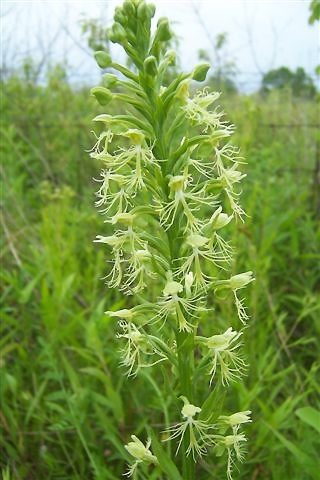Description: This perennial orchid is 1-2½' tall and unbranched. The central stem is light green, terete, glabrous, and somewhat stout. There are 2-5 alternate leaves along each stem, developing from sheaths. They are 2-8" long and ½–2" across, becoming smaller as they ascend the central stem. The light to medium green leaf blades are elliptic, elliptic-oblong, or lanceolate-oblong in shape and smooth along their margins; their veins are parallel. In relation to the stem, the leaf blades are nearly erect and slightly spreading. The central stem terminates in a narrow raceme flowers about 3-8" long. The whitish or yellowish green flowers are arranged all around the central stalk of the raceme on ascending stout pedicels about 1" long. At the base of each pedicel, there is a linear-lanceolate bract about ¾" long.

Each
flower is about ¾" long and across, consisting of 3 petals, 3 sepals, a
nectar spur, and reproductive organs. The upper sepal and upper 2
petals (about ¼" long) form a small hood (upper lip) over the
reproductive organs and nectary opening. The upper sepal is broadly
oblong in shape, while the upper 2 petals are linear to linear-oblong.
The 2 lateral sepals (about ¼" long) are broadly oblong and usually
curve backward from the front of the flower. The lower petal forms a
lower lip that is deeply divided into 3 fan-shaped lobes. The lateral
lobes and usually the central lobe are deeply fringed; less often, the
central lobe is shallowly divided into 2-3 smaller lobes. The fringed
lower lip may be more white than other parts of the flower. At the back
of the flower, there is a narrowly cylindrical nectar spur about ¾"
long that nods downward. The blooming period occurs during mid-summer
and lasts about 3 weeks. The flowers are often fragrant, especially at
night. Fertile flowers are replaced by narrowly ellipsoid seed capsules
about ¾" long. The seed capsules split open to release numerous tiny
seeds, which are distributed by the wind. The root system consists of
fleshy fibrous roots. Sometimes, vegetative offsets develop a short
distance from the mother plant.
Cultivation:
The preference is full or partial sun, moist conditions, and an acidic
soil containing sand, silt-loam, peaty material, or some gravel. Like
other orchids, this species requires the appropriate endomycorrhizal
fungus in the soil for proper growth and development. It can be
difficult to transplant successfully.
Range & Habitat:
The native Green-Fringed Orchid has been found in most areas of
Illinois,
particularly the NE section of the state; it is relatively uncommon.
Habitats include moist prairies and sand prairies, sandy swamps, moist
open woodlands, shrubby bogs, acidic gravelly seeps, low areas along
streams, sandy fields, powerline clearances, and ditches. Green-Fringed
Orchid is more likely to appear in degraded areas than many other
orchids, although it also occurs in higher quality habitats.
Faunal Associations:
The flowers are pollinated primarily by moths, including Noctuid moths
and Sphinx moths. Such species as Anagrapha falcifera
(Celery Looper Moth), Allagrapha aerea (Unspotted
Looper Moth), and Hemaris thysbe (Hummingbird
Clearwing) have been observed sucking nectar from the flowers.
Mammalian herbivores (deer, rabbits, cattle, etc.) sometimes enjoy a
gourmet meal by browsing on the foliage and flowers of this and other
terrestrial orchids.
Photographic Location:
A prairie in Fayette County, Illinois. The photograph of the flowering
plant was taken by Keith & Patty Horn (Copyright © 2009).
Comments:
Because of its greenish flowers, this orchid doesn't stand out from the
background to the same extent as more colorful orchids in its genus.
However, it has a delicate beauty that is peculiarly its own. While
there are many orchids in the Midwest that have greenish flowers, this
orchid is the only one with a deeply fringed lower lip. Compared to the
similar Platanthera leucophaea (Prairie
White-Fringed Orchid), the Green-Fringed Orchid has a lower lip with
more narrow and insubstantial lobes (this applies particularly to the
central lobe). Other species in this genus, e.g. Platanthera
blephariglottis (White-Fringed Orchid) and Platanthera
ciliaris (Orange-Fringed Orchid), have fringed lower lips
that are not divided into major lobes. Thus, not only color, but also
subtle differences in floral structure, are important in the
identification of an orchid species in this interesting genus.